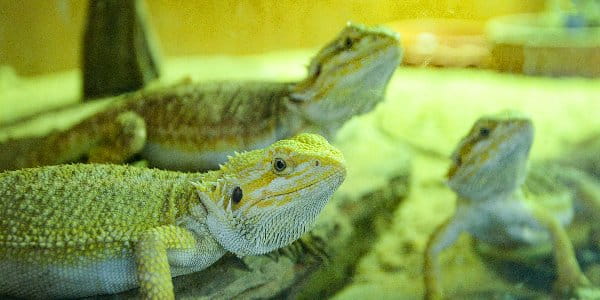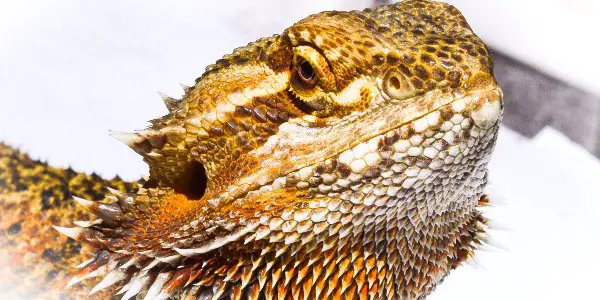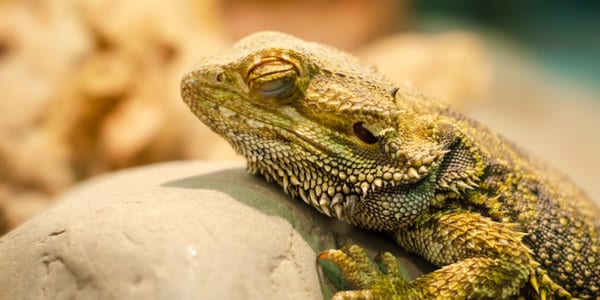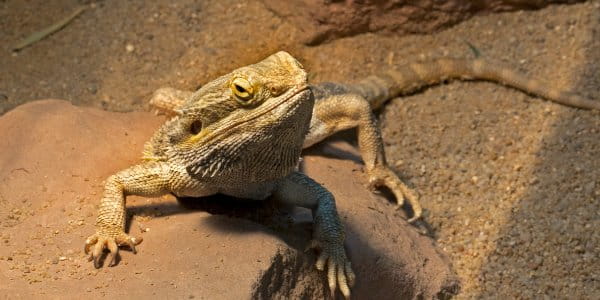Bearded dragons are currently one of the most popular choices for people looking to own a reptile as a pet. Favored for their gentle personalities, cute faces, and easy-to-bond-with nature, it’s obvious why bearded dragon breeding has grown so much over the past few years. You might be wondering how many different colors and types are really out there.
Bearded dragon colors and types are referred to as morphs in the reptile community. Morphs differ from typical wild-type colorations and patterns, and there are more than 20 different beardie morphs out there. You can keep your dragon’s color strong with good care.
The rest of this article will tell you everything you need to know about bearded dragon colors and types, so you can gain a better understanding of the species. Read on to learn more about these lovable little lizards.

What Are the Different Bearded Dragon Types?
Before we start diving into morphs, it’s important to understand the different species of bearded dragons.
There are nine different bearded dragon types. The most popular and basic bearded dragon species is the Pogona vitticeps, which is what you’ll typically see at most pet stores and more casual reptile expos.
However, more species are also kept as pets, including the Pogona vitticeps, the Pogona Henrylawsoni (which also goes by Rankins dragon), and more. While most bearded dragon species are fundamentally similar, you’re still going to get slight variations in personality, temperament, care, and habitat needs.
It’s extremely important to do as much research on your preferred species as you can to ensure that your bearded dragon will be getting the best possible care.
What Is a Bearded Dragon Morph?
A bearded dragon morph is a genetic trait that differs from wild-type traits. These traits can display themselves in different patterns and colors. However, even bearded dragons of the same morph can display different depictions of that particular morph. No two beardies look the same.
If you go to your typical big franchise pet store, you’re probably not going to find any cool bearded dragon morphs.
While wild-type beardies are still beautiful, if you’re interested in more visually appealing traits (and healthier lizards), you should seek out independent breeders and see which morphs they have to offer.
But how many bearded dragon morphs are there, exactly?
How Many Bearded Dragon Morphs Are There?
There are currently over 20 different bearded dragon morphs recognized in the current day reptile community. These morphs are determined by genetics and are often bred with other morphs to make new mutations.
The reptile breeding industry is a vast one, and so many bearded dragons are bred each year to meet the ever-growing demand for bold morphs and bearded dragons as a whole. With this in mind, it’s apparent that there are bound to be mutations.
These mutations are often what lead to the discovery of new morphs. While there are currently around 20 bearded dragon morphs, new morphs with different patterns and colors are bound to be bred in the future.
Are Different Colors and Types of Bearded Dragons More Expensive?
Your average wild Pogona Vitticeps might cost you anywhere from $50-$100, depending on where you live and where you decide to purchase the pet from. But does this cost change depending on which morph you buy?
Different colors and types of bearded dragons are more expensive. Certain bearded dragon morphs cost more than others because certain genetic mutations are rare. For example, wild-type dragons are the most common, which is why they are less expensive.
Here are some different factors that will affect the cost of a particular bearded dragon morph:
- Competition can affect the cost of certain morphs. If you’re seeking a particular type of bearded dragon morph that is commonly sought-after, you might have a harder time trying to find this morph at pet stores and expos.
- If your desired bearded dragon morph is rarer than others, it will cost more. Again, morphs are typically created by genetic mutations, and some of these are harder to come by than others. This rarity can determine how much different colors and types of bearded dragons might cost.
- Different breeders sell at different prices. Reptile breeding is a very time-consuming endeavor, and it also requires a lot of money, effort, and energy– both electrical and physical. Price points for different morphs will vary for each breeder depending on how many resources they have invested into that particular breeding project.
- Desirable patterns, colors, and vibrancy levels can determine how much a beardie will cost. Again, while wild-type bearded dragons tend to be on the more inexpensive side of things, the more aesthetically pleasing morphs will cost a lot more if their visuals are highly desirable.
What Is the Rarest Bearded Dragon Type?
As previously mentioned, there are over twenty different types of bearded dragon morphs and about nine major species. But which type of bearded dragon is the most sought-after one of them all?
The rarest bearded dragon type is said to be the zero, a morph of bearded dragon that typically displays itself as a lizard with no visible patterns or colors. These beardies are generally all white with little to no coloration at all, and they are extremely rare.
If you’re interested in finding a zero morph bearded dragon for your own collection of reptile friends, you aren’t likely to have much luck looking at your routine chain pet stores. To find rare morphs like the zero, you’re going to need to do a lot of searching at reptile expos or seek out a breeder online.
However, this is a pretty uncommon type of bearded dragon. Zero morph bearded dragons usually cost several hundred dollars, so be prepared to fork out a lot of cash if you want to bring one of these beardies home with you.

Can Bearded Dragons Change Color?
Chameleons are known for their fascinating color changes. However, these aren’t the only lizards out there who can change their pigmentation at ease.
Bearded dragons can change color, believe it or not. They’re able to slightly shift their colors from dark to light, often adding or taking away bits of red, orange, and yellow as well. They do this to ward off predators and to help regulate their temperature.
Bearded dragon color changes can be caused by environmental factors such as how warm or cool their habitat is, what other colors are present in the background, and whether or not they think a predator is near.
Understanding bearded dragon color changes is really important for understanding what your little friend is feeling. This is because beardies are often known to turn really dark when they feel threatened, which is something you should keep in mind as you’re handling your pet.
Why Does Your Bearded Dragon’s Coloring Look Dull?
If you notice that your bearded dragon’s coloring looks dull, there’s no need to worry right away.
Your bearded dragon’s coloring might look dull because your reptile is simply shedding. Most lizards need to shed in order to grow, so they will shed their old skin. Bearded dragons are no exception to this rule and will turn dull before shedding.
- Their colors are dull. If you notice that your bearded dragon isn’t looking as vibrant as usual, this could mean that they’re getting ready to shed their old skin to make way for the new.
- There are white pieces of dead skin hanging off of your bearded dragon. Most lizards don’t shed in one go, so it’s common for bearded dragons to shed in pieces.
- Your beardie seems more tired than usual. It takes a lot of energy for your bearded dragon to shed, so if you notice your dragon displaying any lethargic behavior, this might be a sign that they’re going to be shedding soon.
- Your bearded dragon seems less hungry. Appetite loss is not unheard of in the realm of bearded dragon shedding, and can actually be a sign that your little friend will be losing their old skin soon.
- Your bearded dragon is more temperamental than usual. Behavior changes are another common sign that your bearded dragon is almost shedding.
How To Help Your Bearded Dragon Shed Properly?
Here are some ways on how to help your bearded dragon shed properly.
Give Your Bearded Dragon a Bath
Allowing your bearded dragon to soak in dechlorinated water is an excellent way to help with the shedding process and make sure they stay hydrated.
However, it’s important to keep in mind that you should never add any soaps to your bearded dragon baths, as these contain harmful chemicals that can severely harm your little friend.
Never Peel Their Dead Skin
Shedding is a natural process, and unless your beardie is in immediate danger, you should try to interfere with it as little as possible.
Peeling the little pieces of white or gray dead skin you see on your bearded dragon can actually be very harmful to them. Doing this can create sores and even peel back skin that is still attached.
Mist Your Bearded Dragon
Misting the affected areas of your bearded dragon (with dechlorinated water, of course) can help soothe the skin and make the process go smoother overall.
While you can mist each individual part of your beardie as needed, you can also mist the entirety of your tank to provide your beardie with a little extra humidity boost in their habitat.
Watch Out for Sudden Color Changes
Sudden color changes might mean that your bearded dragon is losing circulation on certain parts of its body due to shedding complications.
This is another reason why it’s so important to understand bearded dragon colors and behaviors, but it can be solved by adding a little bit of aloe vera to your beardie to help remove that individual piece of a stuck shed.

How To Enhance the Color of Your Bearded Dragon?
The best bearded dragon color enhancement method isn’t necessarily a particular type of food, supplement, or technique. The best solution is simply good husbandry overall. You can keep your dragon and its colors looking their best with attentive habits and good care.
Here are some tips for enhancing the color of your bearded dragon by making sure your beardie is healthy:
- Feed your bearded dragon a nutritious diet.
- Make sure your bearded dragon has access to ultraviolet light.
- Allow your bearded dragon to exercise.
- Provide your bearded dragon with constant access to clean water.
- Make sure your bearded dragon is getting calcium and vitamins.
Let’s explore each of these tips in further detail.
Feed Your Bearded Dragon a Nutritious Diet
Feeding your bearded dragon a diet with all the right nutrients is one of the best things you can do for your little friend and their overall well-being, including their ability to look and feel their best.
A proper bearded dragon diet should include fruits, veggies, and protein. However, it’s important to do your research on which fruits and vegetables are safe for bearded dragon consumption.
I also recommend buying organic produce for your reptiles to ensure that they don’t accidentally consume any pesticides, which can be extremely harmful to their health, especially since their bodies cannot fight off chemicals the way we do.
As far as protein goes, you should be feeding your bearded dragon different varieties of worms, roaches (such as dubia roaches), and crickets. However, crickets should be fed sparingly as they aren’t as nutritious as other sources of protein like dubia roaches and earthworms. Silkworms should be considered a treat as well.
Again, it’s always important to do your research and consult with a vet when possible to ensure that your bearded dragon is getting all of its nutrient needs met to the fullest.
Make Sure Your Bearded Dragon Has Access to Ultraviolet Light
Another crucial part of bearded dragon husbandry is making sure that your bearded dragon has access to ultraviolet light.
Bearded dragons have constant access to the sun and its cycles in the wild. The sun provides them with the ability to make vitamin D, which is absolutely necessary for calcium absorption.
Allow Your Bearded Dragon To Exercise
Allowing your bearded dragon to exercise is an excellent way to let your reptile friend be as healthy as possible.
Bearded dragons have plenty of space to roam around in the wild. Exercise is so important for their health, and when they’re confined to a habitat in captivity– no matter how amazing your setup might be– this can be hard for them to achieve on their own.
One way to help your beardie exercise is to handle them frequently. You can even let them run around in a supervised space for a little bit, such as a playpen for a small rodent.
Another way to do this is to purchase a harness for your bearded dragon. It sounds ridiculous in theory, but it’s actually quite common (and adorable, of course).
Provide Your Bearded Dragon With Constant Access to Clean Water
Another way to ensure that your bearded dragon is as healthy as possible is to give them constant access to water.
While this sounds like a given, it’s actually such a necessary step for maintaining the overall health of your beardie (and making sure they’re able to show their colors as best as they can). A hydrated bearded dragon is a healthy one.
However, it’s important to note that you should never provide a bearded dragon with water straight from the tap. Many reptile owners mix a dechlorinating solution with their pet’s water to make sure it’s safe to drink and doesn’t contain any harmful metals.
Make Sure Your Bearded Dragon Is Getting Calcium and Vitamins
Another essential factor for bearded dragon health is ensuring that your beardie is getting all the calcium and vitamins they need. One of the most common ways to go about doing this is to mix in supplements with your beardie’s food.
You can visit your local pet store to find multivitamin supplements, calcium supplements, and even all-encompassing supplement mixes that include all the nutrients your beardie might need.
How a Bearded Dragon’s Health Affects Its Color?
While bearded dragons are known for slight color changes, thermoregulation and fear of predators aren’t the only things that affect a beardie’s color.
The health of your bearded dragon can determine whether or not your beardie will display its colors vibrantly. If you have a morph known for vibrancy and bright patterns, with good care, you can expect those physical features to show.
However, it’s a given that an unhealthy animal will not look its best. If your bearded dragon’s colors look dull and your pet looks generally unwell, it’s a good idea to seek a veterinarian’s help to determine if your reptile has an illness.

Final Thoughts
There are so many different bearded dragon colors and types out there. These are often referred to as morphs, and while new traits are constantly being explored, there are currently over twenty known bearded dragon morphs recognized in the reptile world.
A bearded dragon’s color is often an indication of how healthy it is. Unhealthy bearded dragons will look sickly and dull rather than their usual vibrant self, and this is still true for wild types as well. The best solution for color enhancement is simply good care.